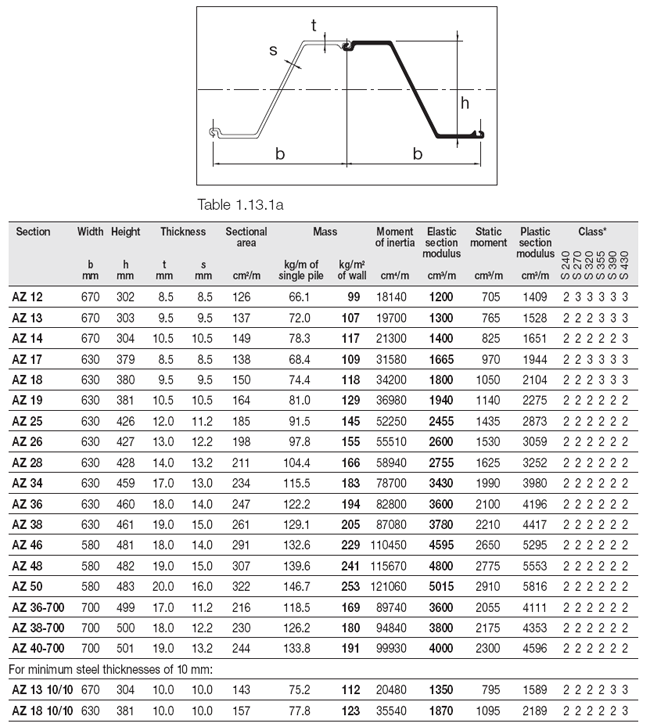
Select the material of the sheet piling from the available AZ14 or AZ 14: User defined, Steel, Concrete, Wood, Synthetic. The pile section must provide the minimum sectional properties after allowance for loss of material due to corrosion, abrasion, and other deleterious effects. The approximate relationship between the angle of internal friction and the dry unit weight for various relative densities and types of granular soils. AZ12 SHEET PILING will automatically determine the value of the material factor γM as given in the Dutch norm, except for User defined for which γM must be entered by the user.
Cantilever concrete walls. Cross sections for walls of prestressed or reinforced concrete shall be proportioned for maximum bending moment, AZ13 shear and any axial load in accordance with paragraphs. Table 3 shows an approximate relationship between the unconfined compressive strength, standard penetration resistance and the unit weight of cohesive soils. Enter the elastic bending stiffness (product of Young’s Modulus E and moment of inertia I) of the pile for each AZ 12 section. The porosity,n, and the void ratio, e, are also shown for coarse grained soils that have a specific gravity, G, equal to 2.68.d. Required cross section for AZ 17 anchored walls. (1) Moment reduction for anchored walls Enter the vertical co-ordinate of the bottom of the pile, in relation to the reference level. Use several sections if the bending stiffness varies along the depth.
Diameter Enter the equivalent diameter of the AZ12 and AZ 12 pile. D-SHEET PILING uses this value as the acting width for the soil reaction. Allow. elas. charac. moment. Rowe (1952, 1955a and b, 1956, 1957a and b) demonstrated that the Free Earth method overestimates the maximum bending moment in AZ17 anchored walls with horizontal tie rods. As mentioned previously, earth pressure is time-dependent in nature. This is particularly true in clay and clayey soils where the AZ 13 values of cohesion, c, and internal friction, , tend to change with time. Enter the modification factor kmod to count for duration life of the synthetic material. For long term situation, the Dutch norm NEN 6702 prescribes a modification factor of 0.45 and for short term situation, a factor of 0.5. Sheet pile structures in clayey soils should be designed for both the period immediately after construction and long term conditions. Limited information indicates that due to creep effects the long term value of c approaches zero and that of somewhere between 20 and 30 degrees. Enter the characteristic value (i.e. without safety factors) of the allowable elastic moment M charac;EL.
The long term case thus approaches that for sheet pile in granular soils. Material factor Enter the partial safety factor γM, only if the User defined material type is selected. m = reduction factor depending on AZ 14 wall geometry, wall flexibility, and foundation soil characteristics. Otherwise, the program will automatically apply the following factors (acc. to the corresponding Eurocode) to calculate the design allowable moment: The function of a AZ13 or AZ 13 structure is often to retain various surface loadings as well as the soil behind it. These surface loads, or surcharge, also exert lateral pressures on the wall which contribute to the active pressure tending to move the AZ17 wall outward. Typical surcharge loadings are railroads, highways, buildings, ore piles, cranes, etc. The reduced bending moment for design is given by max = maximum bending moment predicted by the Free Earth method R Steel: γM = γMo = 1, acc. to Eurocode 3 – Part 5, art. Concrete: γM = γC = 1.1, acc. to Eurocode 2 – Part 1.1, art. Wood: γM = γM,fi = 1 , acc. to Eurocode 5 – Part 1-2, art. Synthetic: γM = 1.2 Reduction factor maximum moment.
Enter the reduction factor applied to the maximum allowable moment fMmax. For the case of a uniform surcharge loading, the conventional theories of earth pressure can be effectively utilized. This reduction factor can be for example factor βB < 1 as defined of Eurocode 3 - Part 5 that takes account of a possible lack of shear force transmission in the interlocks of a AZ14 sheet piling for single and double AZ12 piles. Allow. Elas. design moment. The lateral pressure, due to the uniform surcharge q, is equal to Kq. The design value of the maximum allowable elastic moment Mdesign. EL is automatically calculated by the program using the following formula:
On the other hand, for point, line and strip AZ13 loads the theory of elasticity (Boussinesq Analysis) modified by experiment provides the most accurate solutions. These solutions are summarized in Foundation Design by Wayne C. Teng1 and “Anchored Bulkheads” by Karl Terzaghi. 22 fMmax is the reduction factor applied to the maximum moment.
The limit value M design; Uniform Surcharge - When a uniformly distributed surcharge is applied at the surface, the vertical pressures at all AZ 17 depths in the soil are increased equally. EL is used in the diagram of the moment to help the user to check if the maximum design moment is reached or not. Reduction factor. Without the surcharge the vertical pressure at any depth h would be where is the unit weight of the soil. When a surcharge of intensity q (force/area) is AZ 13 added, the vertical pressures at depth h become. This reduction AZ14 factor can be for example factor βD < 1 as defined in article of Eurocode 3 - Part 5 accounting for the possible reduction due to insufficient shear force transmission in the AZ 14 interlocks. When the soil below the dredge line is granular, the magnitude of the reduction factor Rm is a function of a flexibility number given by.
Enter the reduction factor fEI applied to the stiffness EI. The corrected factor is EIcorrected = EI × fEI. Note to reduction factor Moment reduction factor for granular foundation soils. The AZ17 or AZ 17 loading cases of particular interest in the determination of lateral soil pressures.

